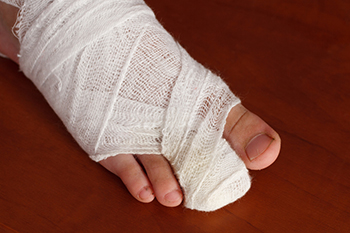Items filtered by date: November 2024
Exercises and Drills to Prevent Running Injuries

Preventing running injuries requires a combination of proper warm-up, focused training, and strength-building exercises. Starting each run with a warm-up is essential to prepare the muscles and joints for the physical demands of running. Dynamic stretches such as leg swings, high knees, and lunges help improve flexibility and activate key muscle groups. Running with purpose, by focusing on technique and form, is another critical step. This involves maintaining an upright posture, engaging the core, and avoiding overstriding to reduce unnecessary strain on the body. In addition to running, strength training exercises, such as calf raises, squats, and lunges, can help build stability and endurance. Incorporating drills like strides or short sprints at the end of easy runs can also improve speed and running efficiency. If you are suffering from foot or ankle pain from running, it is suggested that you consult a podiatrist who can offer you effective treatment and injury prevention techniques.
Exercising your feet regularly with the proper foot wear is a great way to prevent injuries. If you have any concerns about your feet, contact Sarah Urton, DPM of Kitsilano Foot and Ankle Clinic. Our doctor will treat your foot and ankle needs.
How to Prevent Running Injuries
Many common running injuries are caused by overuse and overtraining. When the back of the kneecap starts wearing out and starts causing pain in your knee, this is commonly referred to as runner’s knee. Runner’s knee is a decrease in strength in your quadriceps and can occur if you’re not wearing properly fitted or supporting shoes. To prevent runner’s knee, focusing on hip strengthening is a good idea, as well as strengthening your quads to keep the kneecaps aligned.
What Are Some Causes of Running Injuries?
- One cause of a common running injury is called iliotibial band syndrome.
- Plantar fasciitis is also another common injury.
- Stress fractures can occur from overtraining, lack of calcium, or even your running style.
Best Ways to Prevent Running Injuries
- Wear footwear that fits properly and suits your running needs.
- Running shoes are the only protective gear that runners have to safeguard them from injury.
- Make a training schedule. Adding strengthening exercises as well as regular stretching can help keep you strong and limber and can lessen the possibility of injuries.
- Stretching keeps muscles limber; this will help you gain better flexibility.
If you have any questions please feel free to contact our office located in Vancouver, BC . We offer the newest diagnostic and treatment technologies for all your foot and ankle needs.
Causes of Heel Pain

Heel pain often results from various mechanical causes. The location of the heel pain can help determine its source, with plantar fasciitis being one of the most frequent causes. This condition leads to pain on the bottom of the heel, often felt during the first steps in the morning, or after prolonged rest. Other causes of plantar heel pain include stress fractures, often becoming worse with increased activity, and nerve entrapment, which brings sensations like tingling or burning. Conditions like heel pad syndrome can lead to deep, bruise-like pain in the middle of the heel. Posterior heel pain might be related to Achilles tendinopathy or a Haglund deformity, which causes inflammation around the Achilles tendon. Sever’s disease is common among children, as a result of an inflamed growth plate at the back of the heel. A podiatrist can perform a thorough assessment, including physical exams and imaging if needed, to identify the cause and develop a treatment plan. If you are experiencing heel pain, it is suggested that you schedule an appointment with a podiatrist for an exam and treatment.
Many people suffer from bouts of heel pain. For more information, contact Sarah Urton, DPM of Kitsilano Foot and Ankle Clinic. Our doctor can provide the care you need to keep you pain-free and on your feet.
Causes of Heel Pain
Heel pain is often associated with plantar fasciitis. The plantar fascia is a band of tissues that extends along the bottom of the foot. A rip or tear in this ligament can cause inflammation of the tissue.
Achilles tendonitis is another cause of heel pain. Inflammation of the Achilles tendon will cause pain from fractures and muscle tearing. Lack of flexibility is also another symptom.
Heel spurs are another cause of pain. When the tissues of the plantar fascia undergo a great deal of stress, it can lead to ligament separation from the heel bone, causing heel spurs.
Why Might Heel Pain Occur?
- Wearing ill-fitting shoes
- Wearing non-supportive shoes
- Weight change
- Excessive running
Treatments
Heel pain should be treated as soon as possible for immediate results. Keeping your feet in a stress-free environment will help. If you suffer from Achilles tendonitis or plantar fasciitis, applying ice will reduce the swelling. Stretching before an exercise like running will help the muscles. Using all these tips will help make heel pain a condition of the past.
If you have any questions please contact our office located in Vancouver, BC . We offer the newest diagnostic and treatment technologies for all your foot and ankle needs.
Treatment Options for a Broken Toe

When a toe is broken, a podiatrist can offer several treatment options based on the severity of the injury. A physical examination and an X-ray are typically used to diagnose a broken toe accurately. For minor fractures, the common approach involves buddy taping, which keeps the injured toe stabilized by taping it to an adjacent toe. In more serious cases, where the bone is displaced, the podiatrist may realign the bone to promote proper healing. For more severe fractures, surgery could be necessary, involving the insertion of a pin to secure the bone. After surgery, a shoe or boot with a stiff sole may be needed to minimize pressure and protect the toe during recovery. Following your podiatrist’s instructions is essential for healing as well as a good way to avoid complications. If you believe you have broken your toe, it is suggested that you schedule an appointment with a podiatrist for an exam and treatment.
Broken toes may cause a lot of pain and should be treated as soon as possible. If you have any concerns about your feet, contact Sarah Urton, DPM from Kitsilano Foot and Ankle Clinic. Our doctor will treat your foot and ankle needs.
What Is a Broken Toe?
A broken toe occurs when one or more of the toe bones of the foot are broken after an injury. Injuries such as stubbing your toe or dropping a heavy object on it may cause a toe fracture.
Symptoms of a Broken Toe
- Swelling
- Pain (with/without wearing shoes)
- Stiffness
- Nail Injury
Although the injured toe should be monitored daily, it is especially important to have a podiatrist look at your toe if you have severe symptoms. Some of these symptoms include worsening or new pain that is not relieved with medication, sores, redness, or open wounds near the toe.
If you have any questions, please feel free to contact our office located in Vancouver, BC . We offer the newest diagnostic and treatment technologies for all your foot care needs.
Managing Midfoot Sprains

A foot sprain occurs when the ligaments in the foot are overstretched or torn due to an awkward landing or sudden twisting. This injury often results from activities such as football, snowboarding, and dance, where the body pivots but the foot remains in one place. Foot sprains are classified into three levels. Grade I involves minor tears to the ligament, in grade II the tears are more severe, and with grade III sprains, the ligament is completely torn or detached. Symptoms of midfoot sprains include pain, swelling, bruising, and difficulty bearing weight. A podiatrist can evaluate the severity of your foot sprain and provide treatment, which may involve wearing a splint or boot. Rehabilitation exercises also may be prescribed to strengthen the foot and prevent future injury. In severe cases, surgical repair of the ligaments may be needed. If you have sprained your foot, it is suggested that you schedule an appointment with a podiatrist for an evaluation and treatment.
Foot Pain
Foot pain can be extremely painful and debilitating. If you have a foot pain, consult with Sarah Urton, DPM from Kitsilano Foot and Ankle Clinic. Our doctor will assess your condition and provide you with quality foot and ankle treatment.
Causes
Foot pain is a very broad condition that could be caused by one or more ailments. The most common include:
- Bunions
- Hammertoes
- Plantar Fasciitis
- Bone Spurs
- Corns
- Tarsal Tunnel Syndrome
- Ingrown Toenails
- Arthritis (such as Gout, Rheumatoid, and Osteoarthritis)
- Flat Feet
- Injury (from stress fractures, broken toe, foot, ankle, Achilles tendon ruptures, and sprains)
- And more
Diagnosis
To figure out the cause of foot pain, podiatrists utilize several different methods. This can range from simple visual inspections and sensation tests to X-rays and MRI scans. Prior medical history, family medical history, and any recent physical traumatic events will all be taken into consideration for a proper diagnosis.
Treatment
Treatment depends upon the cause of the foot pain. Whether it is resting, staying off the foot, or having surgery; podiatrists have a number of treatment options available for foot pain.
If you have any questions, please feel free to contact our office located in Vancouver, BC . We offer the newest diagnostic and treatment technologies for all your foot care needs.

